In the evolving landscape of nutritional science, few dietary approaches have sparked as much interest and controversy as the ketogenic diet. Its appeal lies in its promise to burn fat efficiently by shifting the body into a state of ketosis, where fat replaces carbohydrates as the primary fuel source. However, the traditional ketogenic diet, known for its extremely low carbohydrate content, has often been criticized for its lack of dietary fiber. Enter the growing interest in high fiber keto foods—a powerful dietary intersection that not only preserves the metabolic advantages of ketosis but also supports digestive health, blood sugar balance, and sustained energy, particularly when integrated with high-protein nutrition plans.
You may also like : The Ultimate Guide to Choosing a High Protein Diet Name That Fits Your Goals
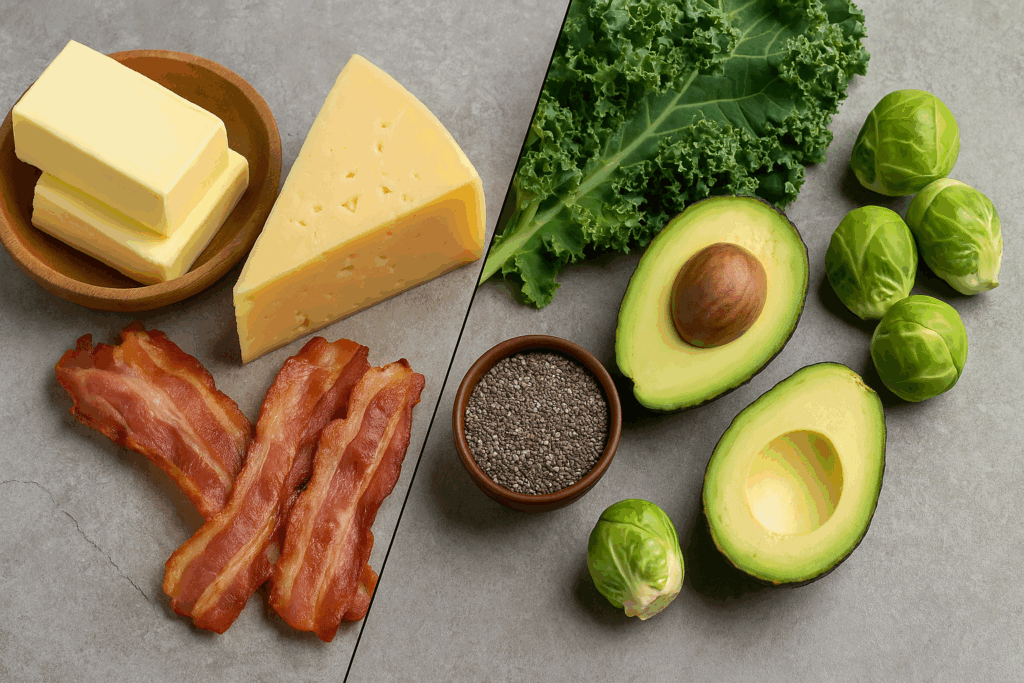
Understanding the Ketogenic Diet and Its Fiber Challenge
The ketogenic diet fundamentally relies on minimizing carbohydrate intake, typically limiting it to about 5-10% of total daily calories. This sharp restriction compels the body to rely on ketone bodies, derived from fat, as an alternative energy source. While this metabolic adaptation offers well-documented benefits—including enhanced fat burning, better insulin sensitivity, and even neuroprotective effects—it also presents an often-overlooked problem: a deficiency in dietary fiber.
Fiber, especially soluble and fermentable types, plays an essential role in maintaining gut health, regulating blood sugar, and promoting satiety. However, most conventional sources of dietary fiber—whole grains, legumes, certain fruits—are too high in carbohydrates to be compatible with standard keto guidelines. This disconnect has prompted researchers and nutrition experts to explore the value and integration of high fiber low carb foods that fulfill both ketogenic and digestive wellness needs.
Why Fiber Matters More Than Ever in Keto Nutrition
Dietary fiber is not just about regular bowel movements. It exerts systemic effects that touch virtually every aspect of human health. Soluble fiber can slow the absorption of glucose, reducing postprandial blood sugar spikes and helping stabilize energy levels. Insoluble fiber enhances intestinal motility and prevents constipation—a common side effect in low-carb dieters. Fermentable fibers act as prebiotics, feeding beneficial gut bacteria that influence everything from immune function to mental health.
In the context of a high-protein ketogenic plan, fiber takes on even greater significance. Protein-rich diets, while excellent for muscle maintenance and metabolic rate, can be taxing on the kidneys and digestive tract if not balanced with adequate fiber. High fiber keto foods help counteract this by improving nitrogen balance, optimizing gut transit time, and reducing the production of potentially harmful byproducts like ammonia in the colon. Furthermore, they support hormonal signaling mechanisms that regulate appetite, making it easier to adhere to a calorie-controlled regimen.

Exploring the Landscape of High Fiber Keto Foods
High fiber keto foods are not mythical unicorns—they exist in abundance when one knows where to look. Many non-starchy vegetables, seeds, nuts, and select fruits offer a high fiber-to-net carb ratio that suits ketogenic guidelines. Foods such as chia seeds, flaxseeds, avocados, artichokes, and leafy greens like spinach and kale deliver significant amounts of both soluble and insoluble fiber without pushing one out of ketosis.
One of the lesser-known members of this category is konjac root, commonly used to make shirataki noodles. It is rich in glucomannan, a soluble fiber with powerful water-binding properties that enhance satiety and glycemic control. Another standout is psyllium husk, which is often used in keto baking to replicate the texture of traditional bread while boosting fiber content. Almonds and walnuts not only offer healthy fats and protein but also contribute to the low carb high fiber diet model with their natural fiber richness.
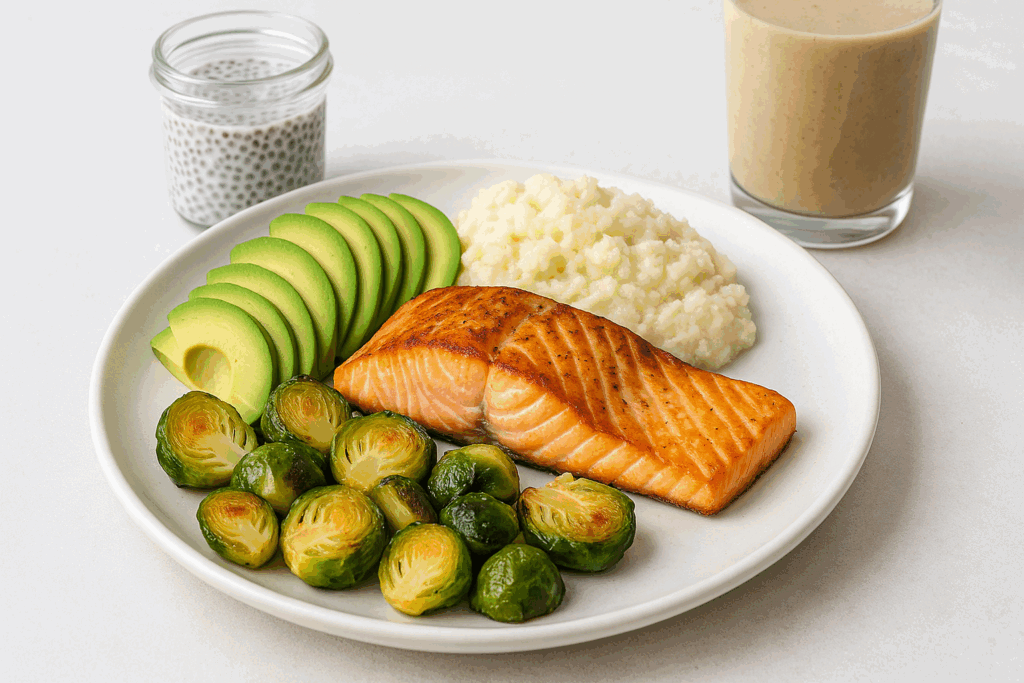
Integrating High Fiber Low Carb Foods into Protein-Packed Diets
High protein diets are frequently lauded for their muscle-preserving and appetite-controlling benefits, but they are most effective when paired with metabolic balance and digestive support. This is where high fiber low carb foods list becomes an indispensable tool for keto practitioners. Including fibrous vegetables like broccoli, Brussels sprouts, and cauliflower alongside protein sources such as eggs, chicken, and fish creates nutrient synergy that enhances bioavailability and satiety.
For example, a post-workout meal consisting of grilled salmon served over a bed of roasted Brussels sprouts and avocado delivers high-quality protein, omega-3 fats, and fiber-rich plant compounds that reduce inflammation and support recovery. Likewise, a breakfast smoothie incorporating unsweetened almond milk, chia seeds, a scoop of whey protein isolate, and a handful of spinach checks all the boxes for a nutrient-dense, low carb high fiber meal.
These pairings not only optimize macronutrient ratios but also ensure a diversified intake of micronutrients, antioxidants, and phytochemicals. This holistic approach promotes sustainable energy, reduces inflammation, and helps maintain lean body mass—all critical factors for individuals pursuing long-term health and fitness goals.
High Fiber Keto Foods: Bridging the Gap Between Gut Health and Ketosis
The inclusion of high fiber keto foods offers a crucial bridge between two seemingly opposing nutritional goals: maintaining ketosis and fostering gut microbiome diversity. Research increasingly supports the notion that a healthy gut microbiota contributes to better metabolic flexibility, immune resilience, and even mood stability. Yet, the traditional keto diet has been shown to reduce microbial diversity due to its limited fiber intake.
This is where strategic incorporation of prebiotic-rich, low carb fiber sources can make a difference. For instance, Jerusalem artichokes and dandelion greens are rich in inulin, a fermentable fiber that supports bifidobacteria proliferation. When integrated into a high-protein, high-fat meal, these ingredients support both satiety and microbial health without compromising ketosis.
Even small dietary tweaks, such as swapping lettuce for arugula or adding hemp seeds to Greek yogurt, can incrementally improve fiber intake and microbiota support. Over time, these adjustments contribute to a healthier gut environment, which in turn reinforces the body’s ability to metabolize fats efficiently and maintain energy equilibrium.
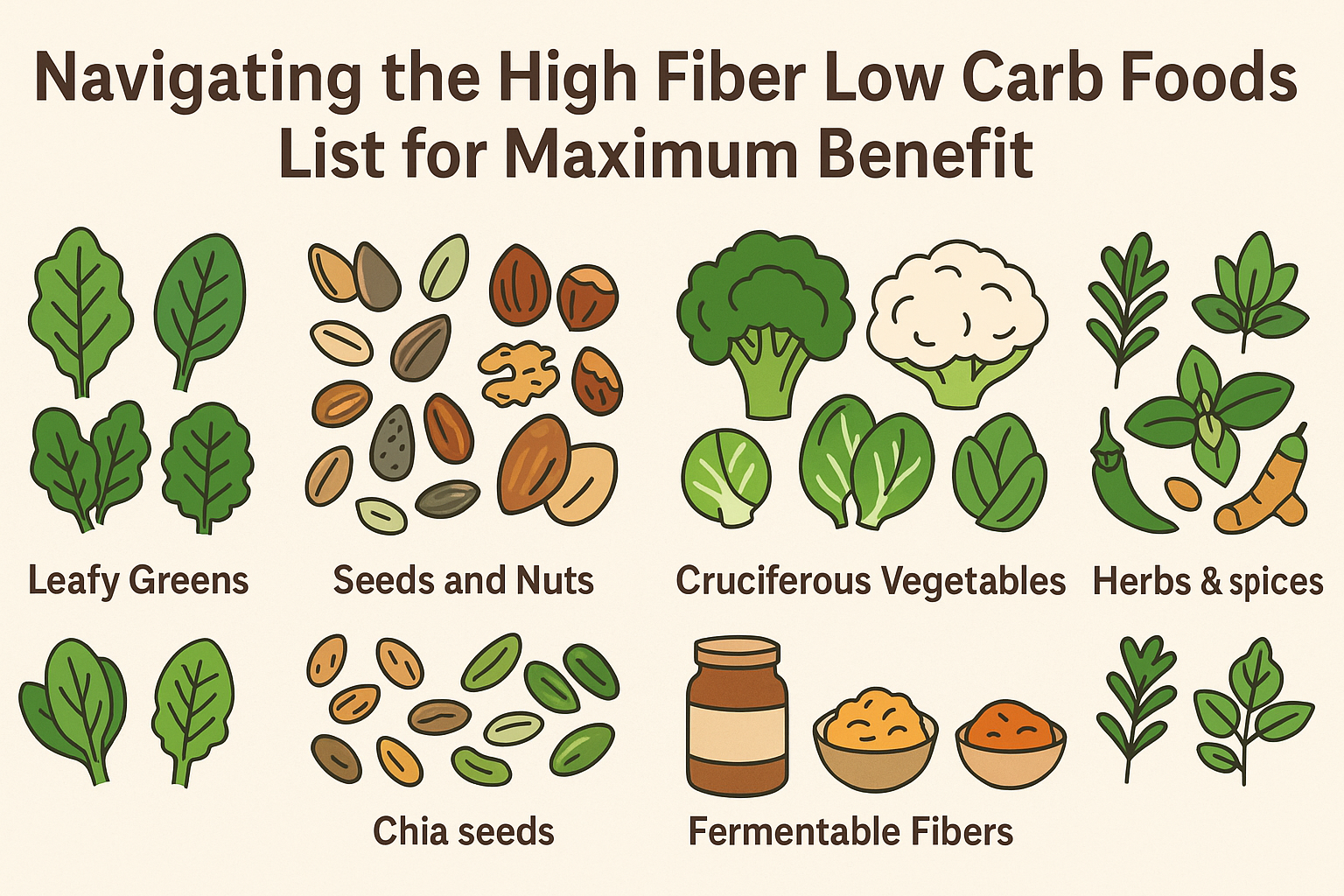
Navigating the High Fiber Low Carb Foods List for Maximum Benefit
While enthusiasm around keto-friendly fiber is growing, practical implementation still requires strategic planning. Navigating a high fiber low carb foods list can help streamline grocery shopping and meal planning. Think of it as a nutritional compass guiding the integration of optimal ingredients that support multiple physiological systems.
Consider categories such as leafy greens (spinach, collard greens, Swiss chard), cruciferous vegetables (broccoli, cabbage, cauliflower), and seeds (chia, flax, pumpkin) as foundational staples. These foods not only contain low net carbs but also provide a broad spectrum of vitamins and minerals essential for enzymatic processes. Likewise, berries like raspberries and blackberries offer an occasional sweet indulgence with surprisingly high fiber content per serving.
Even certain herbs and spices—such as turmeric, ginger, and basil—contain small but significant amounts of fiber along with anti-inflammatory phytochemicals. Including them in daily meal prep not only enhances flavor but also contributes to the low carb high fiber diet profile that supports metabolic and digestive health. The goal is not to count grams obsessively but to create meals that are functionally diverse, enjoyable, and deeply nourishing.
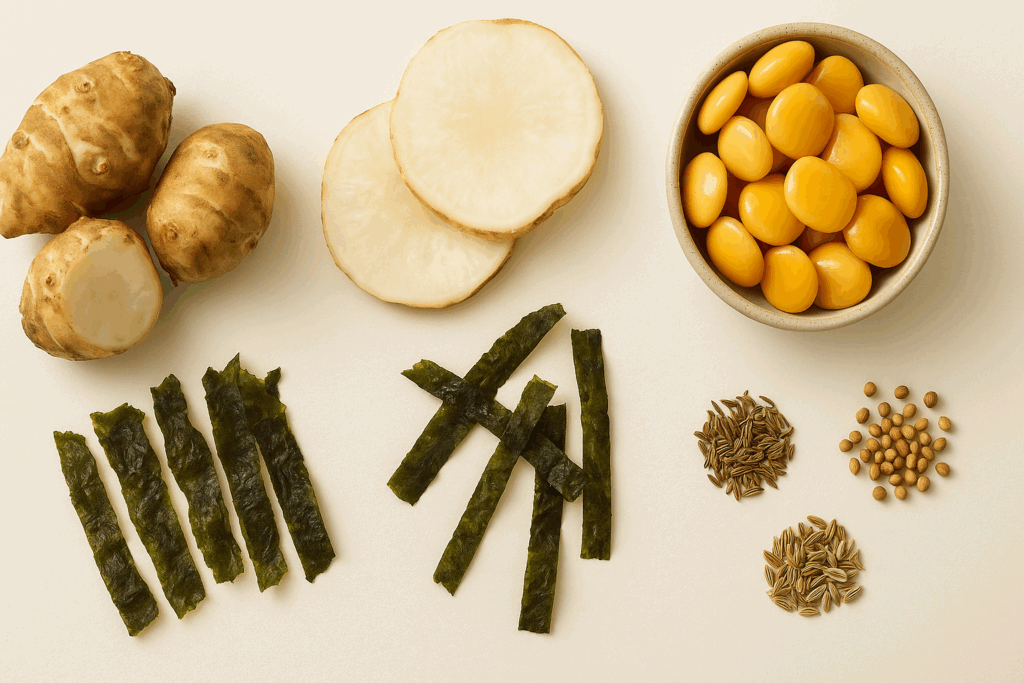
Advanced Functional Foods to Boost Keto Fiber Intake
While most keto practitioners are familiar with broccoli and chia seeds, a growing array of functional foods can diversify the fiber profile without exceeding carbohydrate limits. Jerusalem artichokes, for instance, are rich in inulin and can be spiralized into noodles or roasted as a side dish. Celeriac (celery root), a lesser-used tuber, offers a low glycemic alternative to potatoes with substantial fiber content.
Lupini beans, when fermented or thoroughly soaked, provide a nearly zero net carb snack that is high in fiber and plant-based protein. Seaweed varieties like wakame and nori are keto-compatible and contain alginates and fucoidans—non-digestible polysaccharides that have prebiotic potential and anti-inflammatory properties. Even spices like cumin, coriander, and fennel contain small but bioactive fiber fractions that enhance microbiota composition and digestive efficiency.
The Role of Polyphenol-Fiber Interactions in Keto Metabolism
An emerging area of interest in nutritional biochemistry is the interplay between dietary fiber and polyphenols. These plant compounds, found abundantly in berries, herbs, and seeds, have limited bioavailability in their native forms. However, when bound to dietary fiber, especially in the lignin or pectin matrix, they become substrates for microbial fermentation.
This interaction enhances the production of bioactive metabolites that modulate inflammation, mitochondrial function, and even circadian rhythm. For example, ellagitannins in raspberries and pomegranates convert to urolithins in the gut, compounds that support autophagy and muscle health—key concerns for individuals on high-protein ketogenic diets. This synergistic relationship underscores the benefit of whole food sources over isolated supplements.
The Metabolic Edge: How Low Carb Fiber Enhances Fat Oxidation and Insulin Sensitivity
One of the most underrated benefits of low carb fiber lies in its ability to improve insulin sensitivity and enhance fat oxidation. By slowing glucose absorption and flattening insulin curves, soluble fiber can prolong the body’s access to fatty acids as an energy source. This metabolic advantage is particularly beneficial for individuals with insulin resistance, metabolic syndrome, or type 2 diabetes who struggle with energy crashes and fat storage.
When paired with high-quality protein and healthy fats, low carb fiber creates a hormonal environment conducive to lean body composition and sustained energy. The steady release of glucose minimizes hunger hormones like ghrelin while amplifying satiety signals such as peptide YY (PYY) and glucagon-like peptide-1 (GLP-1). This not only curbs cravings but also supports cognitive clarity and emotional stability, further enhancing adherence to dietary goals.
From an athletic performance perspective, fiber-fueled ketosis may also improve endurance by stabilizing blood sugar and reducing gastrointestinal distress during prolonged exercise. Athletes who rely on fat adaptation for fuel can benefit from the anti-inflammatory properties of fiber-rich plant foods while minimizing the risk of performance-compromising blood sugar fluctuations.
Daily Habits to Increase Low Carb High Fiber Intake Without Compromising Ketosis
Achieving a low carb high fiber diet does not require drastic overhauls. Instead, it involves subtle shifts in food choices, preparation methods, and culinary creativity. One effective habit is to prioritize whole, unprocessed foods over packaged “keto” products, which often lack fiber and include questionable ingredients. Home-cooked meals centered on whole vegetables, animal proteins, and healthy fats provide more control over macronutrient balance and fiber content.
Incorporating fermented foods like sauerkraut or kimchi can further support gut health without adding significant carbohydrates. These foods enhance microbial diversity and may improve nutrient absorption, especially when consumed with fibrous vegetables. Similarly, using low-carb baking alternatives that include almond flour and psyllium husk can create satisfying baked goods that contribute to daily fiber goals.
Meal timing and composition also play a role. Starting the day with a fiber-rich breakfast such as chia pudding or a green protein smoothie sets the tone for balanced blood sugar throughout the day. Likewise, planning fiber-forward snacks like celery with almond butter or cucumber slices dipped in guacamole can sustain energy and prevent impulsive eating. Over time, these incremental habits yield compounded benefits in both metabolic function and dietary compliance.
The Fiber Diversity Spectrum: Beyond Soluble and Insoluble
Most dietary discussions around fiber end with a simplistic bifurcation into soluble and insoluble types. However, fiber is chemically diverse, and its physiological impact varies widely depending on its structure, viscosity, and fermentability. For example, beta-glucans (found in small amounts in low-carb mushrooms like oyster mushrooms) are viscous soluble fibers with cholesterol-lowering effects, while resistant starches—less common in keto but present in cooled, cooked green bananas or some legumes—have powerful prebiotic effects.
Arabinoxylans, found in flaxseeds and some cruciferous vegetables, modulate immune signaling through their influence on gut-associated lymphoid tissue. Lignin, a complex polyphenolic fiber found in flax and chia seeds, resists fermentation and contributes to fecal bulk while simultaneously binding bile acids and potentially reducing estrogen recirculation. Understanding these functional nuances helps individuals tailor their fiber intake not only for digestive regularity but also for specific health outcomes like hormonal balance, cardiovascular health, and immune modulation.
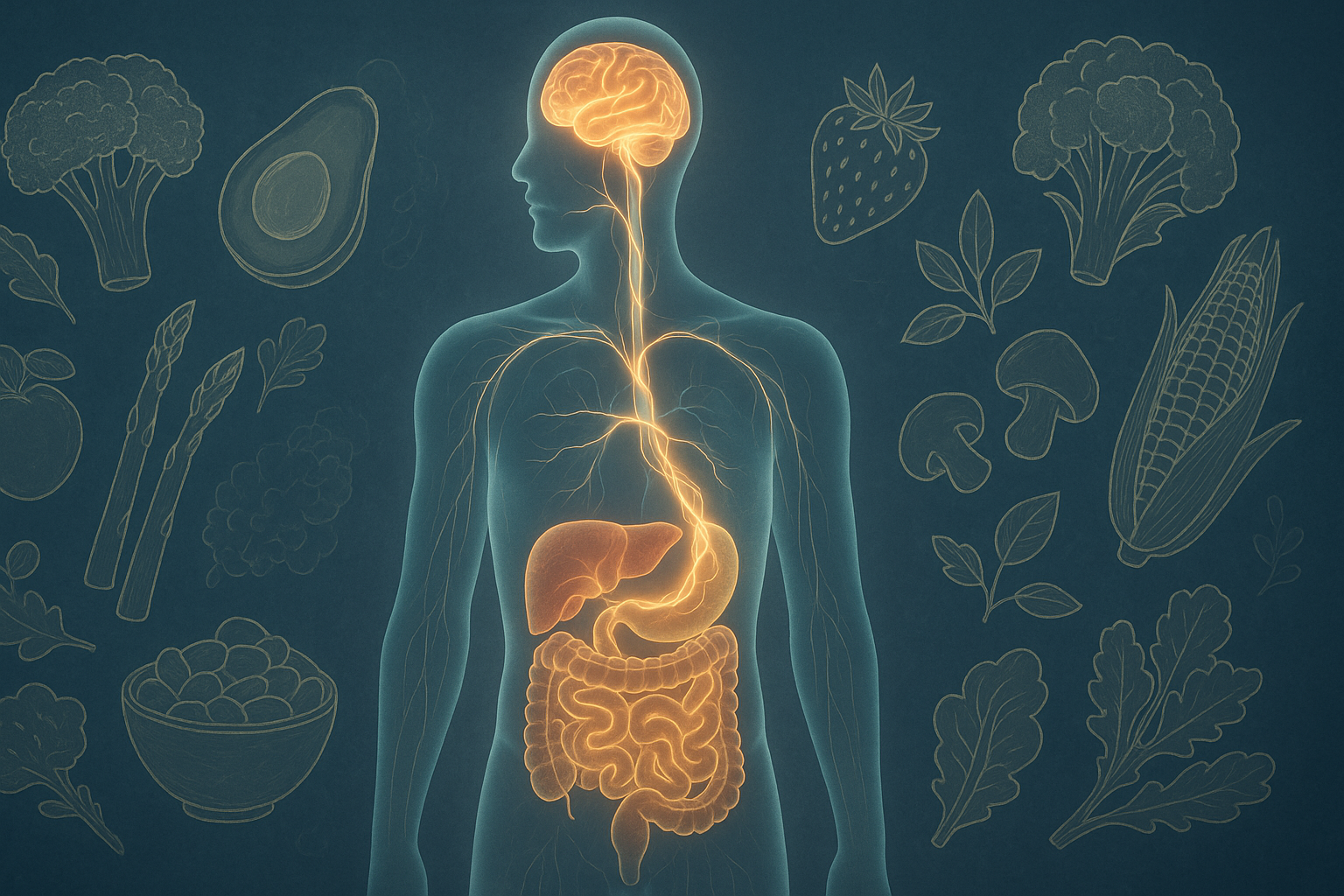
The Gut-Liver-Brain Axis: A Trifecta Influenced by High Fiber Keto Foods
Modern nutritional science recognizes the gut as more than a digestive organ. It is an interface that connects to the immune system, the endocrine system, and the central nervous system. The gut-liver-brain axis represents a bidirectional communication network that regulates everything from emotional behavior to glucose homeostasis.
High fiber keto foods modulate this axis by enhancing microbial diversity and increasing SCFA production. Butyrate, for example, strengthens tight junctions in the intestinal epithelium, reducing permeability (“leaky gut”) and preventing endotoxins from entering the bloodstream—a critical mechanism for reducing neuroinflammation and hepatic insulin resistance. Propionate influences gluconeogenesis and appetite regulation through its interaction with the liver and hypothalamus, while acetate may impact lipid metabolism and thermogenesis.
For ketogenic dieters, especially those combining high protein intake, the importance of these fibers cannot be overstated. A gut microbiome skewed toward proteolytic fermentation can generate compounds like ammonia and p-cresol, which have been implicated in systemic inflammation and neurological dysfunction. Adequate fiber intake shifts microbial activity toward saccharolytic pathways, fostering a symbiotic environment that supports whole-body health.
High Fiber Keto Foods for Weight Management and Appetite Control
Weight loss and appetite regulation remain top priorities for many who adopt keto and high-protein diets. High fiber keto foods provide a unique advantage in this area by influencing both mechanical and hormonal satiety pathways. Soluble fiber swells in the stomach, creating a sense of fullness that reduces the likelihood of overeating. Additionally, fiber slows gastric emptying, prolonging the presence of nutrients in the digestive tract and enhancing nutrient signaling.
Hormonal changes induced by fiber consumption—such as increased GLP-1 and reduced ghrelin—further support appetite regulation. When paired with high-protein meals, which are inherently satiating due to their thermogenic and muscle-preserving properties, the result is a powerful tool for calorie control without the sensation of deprivation.
Moreover, the blood sugar stabilization provided by low carb fiber helps prevent the reactive hypoglycemia that often triggers hunger and cravings. This steady-state energy model facilitates fat loss while preserving lean mass, a cornerstone of healthy weight management. Importantly, the emphasis on whole, fiber-rich foods also fosters mindful eating, reducing the reliance on hyper-palatable, ultra-processed options that derail progress.
Balancing Gut Microbiota on a High Protein, Low Carb, High Fiber Diet
The intersection of gut microbiota and ketogenic nutrition is an area of rapidly expanding research interest. A high-protein, low carb, high fiber diet can have profound effects on microbial composition, but the direction of these changes depends largely on fiber intake. Without adequate fermentable substrates, protein fermentation in the colon can produce potentially harmful metabolites like ammonia, phenols, and hydrogen sulfide.
High fiber keto foods mitigate this risk by providing non-digestible carbohydrates that beneficial microbes convert into short-chain fatty acids (SCFAs) such as butyrate, acetate, and propionate. These SCFAs exert anti-inflammatory effects, improve gut barrier integrity, and even influence central appetite regulation through the gut-brain axis.
Balancing the protein-to-fiber ratio is essential for long-term gut health. This can be achieved by integrating a variety of plant-based fibers alongside animal-based protein sources. For example, pairing grilled chicken with a fiber-rich kale and avocado salad not only enhances nutrient density but also supports microbial diversity. The result is a symbiotic relationship between dietary components that promotes both metabolic and gastrointestinal harmony.
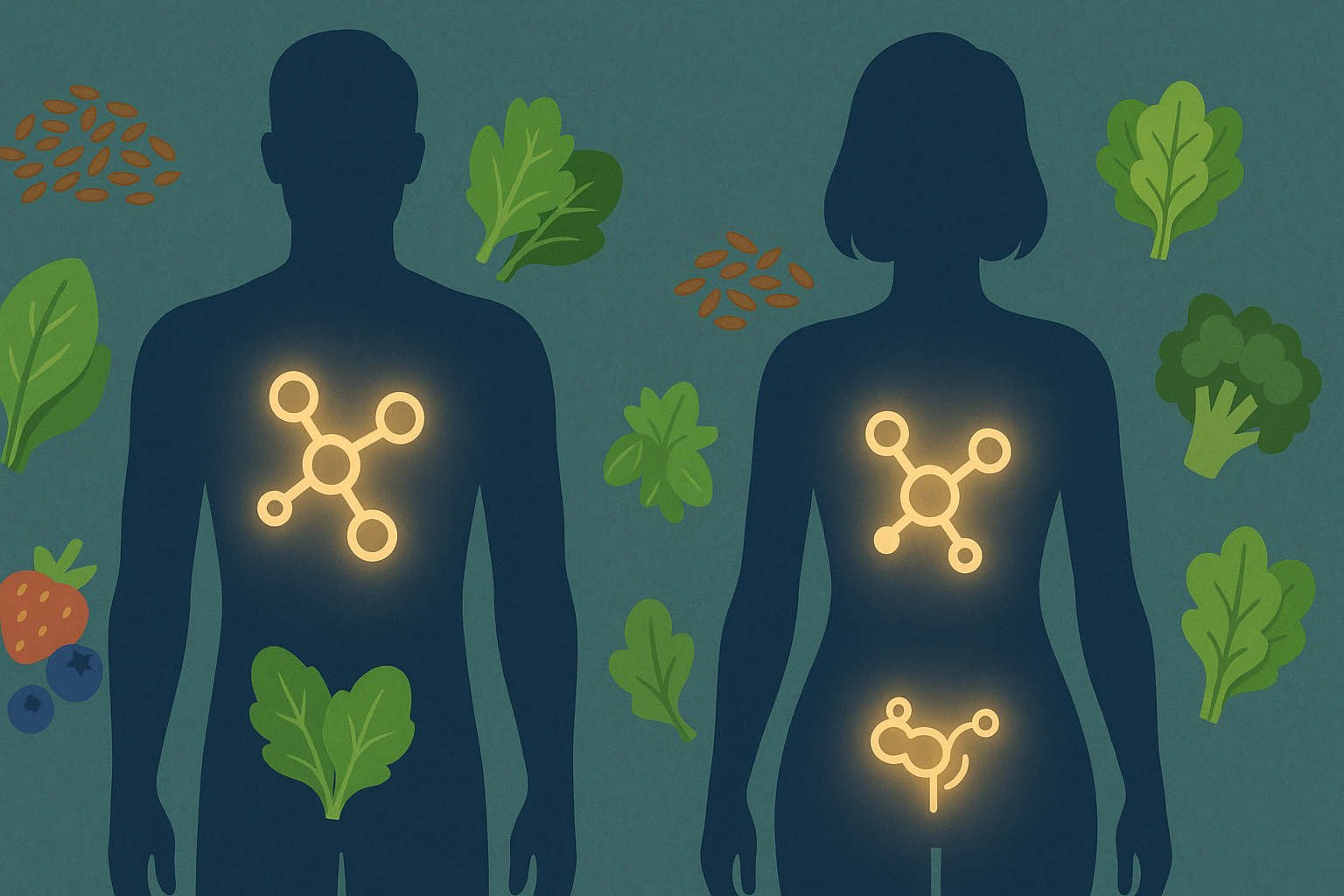
Gender-Specific Benefits and Hormonal Implications
Men and women may experience different outcomes on a high fiber low carb diet due to hormonal dynamics. In women, soluble fiber can bind to estrogen metabolites in the gut, reducing recirculation and potentially improving conditions like estrogen dominance or polycystic ovarian syndrome (PCOS). In men, fiber’s role in testosterone metabolism is more nuanced; while excess fiber can reduce serum testosterone, moderate intake within a low carb context appears to support healthy androgen balance by improving insulin sensitivity and reducing visceral fat.
Moreover, both sexes benefit from fiber’s role in cortisol modulation. Chronic stress elevates cortisol, which can increase gluconeogenesis and promote fat storage, especially around the abdomen. By stabilizing blood glucose and supporting microbiome-derived neurotransmitters like GABA and serotonin, high fiber keto foods may reduce the stress response and support emotional resilience.
Athletic Performance and Recovery: Fiber as a Recovery Enhancer
While fiber is not typically associated with performance nutrition, its impact on recovery and resilience should not be underestimated. SCFAs derived from fermentable fiber enhance mitochondrial efficiency and reduce oxidative stress, both of which are crucial for athletic recovery. Furthermore, fibers that modulate the gut barrier can lower systemic inflammation and muscle catabolism following intense training.
Athletes on ketogenic or high-protein diets often face challenges like delayed gastric emptying, constipation, or gut permeability. Including low carb fiber sources like dandelion greens, endive, or fermented vegetables can alleviate these issues and improve nutrient assimilation. Additionally, fiber-rich foods containing quercetin (e.g., red onions, capers) offer anti-histamine effects that may reduce exercise-induced asthma or allergies.
A Holistic Approach to Sustainable Keto Nutrition
Ultimately, the value of high fiber keto foods extends beyond macronutrient math. It reflects a shift toward more holistic, sustainable, and health-forward dietary practices. Rather than fixating solely on ketone levels or protein grams, this approach encourages a deeper understanding of food quality, digestive ecology, and the interconnectedness of bodily systems.
By emphasizing whole foods rich in low carb fiber, individuals can achieve the metabolic benefits of ketosis while supporting long-term health markers such as cardiovascular function, cognitive clarity, hormonal balance, and immune resilience. This paradigm recognizes that sustainable nutrition is not about restriction, but about intelligent inclusion—strategically selecting foods that nourish both body and microbiome.
Frequently Asked Questions: High Fiber Keto Foods and Protein-Focused Nutrition
1. How can high fiber keto foods improve digestion without interrupting ketosis?
High fiber keto foods play a dual role in the digestive system: they support gut motility and microbial diversity without contributing to significant glucose production. Unlike digestible carbohydrates, fibers like inulin, glucomannan, and cellulose resist enzymatic breakdown, allowing them to ferment in the colon instead of raising blood sugar. This fermentation process generates short-chain fatty acids that nourish gut cells and fortify the intestinal lining. Importantly, these fibers do not elevate insulin levels, so ketosis remains intact. By enhancing regularity, promoting beneficial bacteria, and avoiding glycemic spikes, high fiber keto foods offer a seamless digestive advantage within a ketogenic framework.
2. What are the most effective ways to transition into a low carb high fiber diet?
Transitioning into a low carb high fiber diet can be optimized by gradually increasing fiber intake while slowly reducing carbohydrates. This strategy minimizes digestive discomfort, such as bloating or cramping, that may occur when fiber levels rise too quickly. Begin by integrating small servings of high fiber low carb foods like zucchini, chia seeds, or spinach into existing meals. Hydration is critical; fiber absorbs water, and insufficient fluid intake can counteract its benefits. Additionally, spacing fiber-rich foods throughout the day rather than concentrating them in one meal allows the gut to adapt more comfortably to the change.
3. How do high fiber low carb foods affect athletic recovery and endurance?
High fiber low carb foods support recovery and endurance in athletes by mitigating systemic inflammation and stabilizing energy output. While not direct energy sources, certain types of fiber enhance mitochondrial efficiency through their fermentation byproducts, notably butyrate. This short-chain fatty acid reduces oxidative stress and strengthens the intestinal barrier, lowering the risk of exercise-induced gastrointestinal symptoms. Moreover, a low carb fiber intake reduces blood sugar volatility, promoting sustained focus and performance during extended workouts. For endurance athletes on a ketogenic protocol, fiber-rich foods like leafy greens, seaweed, and fermented vegetables can be instrumental in maintaining peak physical function.
4. What are some advanced meal planning strategies using the high fiber low carb foods list?
Using the high fiber low carb foods list as a template, advanced meal planning involves categorizing fiber types, aligning them with macronutrient goals, and rotating ingredients for microbiome diversity. For instance, alternate between insoluble fibers (e.g., cauliflower, flaxseed) and fermentable fibers (e.g., asparagus, Jerusalem artichokes) to support different gut functions. Batch cooking recipes like coconut flour muffins or psyllium-rich flatbreads can simplify daily intake. Incorporating seasonal vegetables ensures phytonutrient variety while maintaining low net carbs. Pairing these with quality proteins and fats enables a nutrient-dense approach that supports metabolic goals while preventing dietary monotony.
5. Can a high fiber low carb approach help with hormone regulation?
Yes, a high fiber low carb approach can positively influence hormone balance, particularly in relation to insulin, estrogen, and cortisol. Soluble fibers bind to excess estrogen in the gut, preventing its recirculation and potentially alleviating hormone-driven conditions like PCOS or PMS. The stabilization of blood glucose through low carb fiber intake also dampens cortisol spikes associated with hypoglycemia. Additionally, SCFAs produced from fiber fermentation influence leptin and ghrelin—the hormones responsible for hunger and satiety. By aligning hormonal rhythms through dietary consistency and fiber diversity, this nutritional strategy supports both reproductive and metabolic health.
6. Are there benefits of combining fermented foods with high fiber keto foods?
Combining fermented foods with high fiber keto foods creates a synergistic effect on gut health by delivering both prebiotics and probiotics. Fermented vegetables like sauerkraut or kimchi contain live beneficial bacteria, while fibers from foods like flaxseeds or avocados provide the fuel these microbes need to thrive. This combination enhances microbial diversity, supports SCFA production, and improves nutrient absorption. It can also strengthen the gut barrier and modulate immune responses, which is particularly beneficial for those dealing with autoimmune issues. Together, these food categories lay a robust foundation for digestive and systemic wellness within a ketogenic model.
7. What lesser-known high fiber keto foods offer unique health advantages?
Some lesser-known high fiber keto foods include artichokes, dandelion greens, lupini beans, and seaweed. Artichokes are rich in inulin, a prebiotic that supports bifidobacteria and improves cholesterol levels. Dandelion greens offer both fiber and liver-supporting antioxidants, making them ideal for metabolic detoxification. Lupini beans, when properly prepared, provide high fiber with nearly zero net carbs and are especially beneficial for plant-based ketogenic dieters. Seaweed varieties like kelp and nori add soluble fiber along with iodine and polyphenols, supporting thyroid function and gut ecology. Including these unique foods diversifies the nutritional profile while staying compliant with low carb high fiber diet principles.
8. How do high fiber keto foods influence mental clarity and mood?
High fiber keto foods contribute to improved mental clarity and mood by supporting the gut-brain axis. The gut microbiota ferments dietary fiber into SCFAs that influence neurochemicals like serotonin and GABA. These neurotransmitters play a critical role in regulating stress, anxiety, and mood stability. Additionally, stable blood sugar resulting from a low carb high fiber diet helps prevent cognitive fatigue and irritability. Emerging research suggests that diverse fiber intake may enhance BDNF (brain-derived neurotrophic factor), a protein associated with memory and neuroplasticity. The cumulative impact is a more balanced, focused, and resilient mental state.
9. What are some long-term lifestyle benefits of maintaining a low carb high fiber diet?
Maintaining a low carb high fiber diet offers long-term benefits that go far beyond weight control. Sustained fiber intake helps maintain a healthy gut microbiome, which in turn supports immune function, skin health, and even bone density. The consistent regulation of blood sugar reduces the risk of chronic conditions like type 2 diabetes and cardiovascular disease. Over time, adherence to this diet can also reduce markers of systemic inflammation, support joint health, and contribute to healthier aging. Importantly, it fosters mindful eating habits and food quality awareness, encouraging a lifelong relationship with nutrient-dense, minimally processed foods.
10. How does fiber diversity enhance the effectiveness of high fiber keto foods?
Fiber diversity enhances the effectiveness of high fiber keto foods by engaging a broader spectrum of gut microbes and maximizing short-chain fatty acid production. Different fibers act on specific bacterial strains, so consuming a variety of sources—from nuts and seeds to fibrous vegetables—ensures a robust and resilient microbiota. This diversity also minimizes the risk of gastrointestinal stagnation or dysbiosis, which can occur on monolithic diets. Furthermore, a wider fiber profile introduces different phytochemicals that collectively support immune modulation, detoxification, and oxidative stress reduction. By rotating items from the high fiber low carb foods list, individuals can achieve a more balanced, sustainable, and therapeutically potent ketogenic experience.
Conclusion : Embracing Fiber as a Foundational Pillar
As the ketogenic movement continues to evolve, the integration of high fiber low carb foods will likely emerge as a defining characteristic of its next phase. No longer will keto be synonymous with bacon and butter alone. Instead, it will encompass a broader spectrum of nutrient-dense, fiber-rich foods that honor both tradition and innovation in dietary science.
This future-forward vision is already taking shape in emerging culinary trends, functional food products, and evidence-based nutrition protocols. High fiber keto foods are not a compromise but a breakthrough—a way to reconcile metabolic flexibility with digestive wellness, performance optimization, and long-term vitality. For health-conscious individuals seeking a powerful, protein-packed nutrition plan that doesn’t neglect the gut, the message is clear: fiber is not the enemy of keto. It is its greatest ally.
Further Reading:
16 High-Fiber, Low-Carb Recipes for Weight Loss





